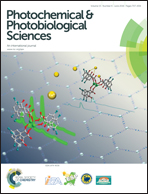Photodeoxygenation of dinaphthothiophene, benzophenanthrothiophene, and benzonaphthothiophene S-oxides†
Abstract
Photoinduced deoxygenation of dibenzothiophene S-oxide (DBTO) has been suggested to release atomic oxygen [O(3P)]. To expand the conditions and applications where O(3P) could be used, generation of O(3P) at longer wavelengths was desirable. The sulfoxides benzo[b]naphtho-[1,2,d]thiophene S-oxide, benzo[b]naphtho[2,1,d]thiophene S-oxide, benzo[b]phenanthro[9,10-d]thiophene S-oxide, dinaphtho[2,1-b:1′,2′-d]thiophene S-oxide, and dinaphtho[1,2-b:2′,1′-d]thiophene S-oxide all absorb light at longer wavelengths than DBTO. To determine if these sulfoxides could be used to generate O(3P), quantum yield studies, product studies, and computational analysis were performed. Quantum yields for the deoxygenation were up to 3 times larger for these sulfoxides compared to DBTO. However, oxidation of the solvent by these sulfoxides resulted in different ratios of oxidized products compared to DBTO, which suggested a change in deoxygenation mechanism. Density functional calculations revealed a much larger singlet–triplet gap for the larger sulfoxides compared to DBTO. This led to the conclusion that the examined sulfoxides could undergo deoxygenation by two different mechanisms.


 Please wait while we load your content...
Please wait while we load your content...